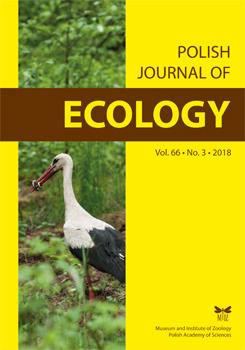The impact of the European beaver Castor fiber on deadwood resources near dams on the rivers of Wigry National Park (northeastern Poland) has been analyzed. The river sampling area was subdivided into the flooded zone, scarp and upland.
We found that beaver feeding was limited to the flooded zone and the scarp. Within a distance of 40 m of the river, beavers browsed 75% of all deadwood pieces (wood debris, stumps, dead trees). The wood generated via direct browsing by beavers made up 5% (3.29 m3/ha) of the total wood volume and 35% (641 pieces/ha) of the total number of wood pieces in this region. The beavers mostly left small pieces of wood (with a mean diameter of about 4 cm) at an area after feeding. The deadwood volume and number of pieces were significantly different in front and behind the dam only in the flooded zone. The volume of deadwood in front of the dam in the flooded zone was higher by 65% than behind the dam (102 and 62 m3/ha, respectively), and the number of pieces was higher by 75% (2200 and 1200 pieces/ha, respectively).
We prove that beavers generate the majority of dead wood indirectly – by flooding a part of the area. This results leads to conclusion that frequent flooding of a given area may lead to limiting the source of deadwood in the long term. We also confirm that through direct browsing, beavers produce small amounts of thin dead wood with less usefulness for other groups of animals, thus in this way beavers are not able to provide high-quality deadwood resources.





